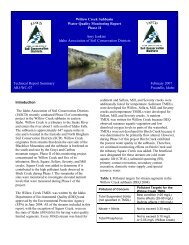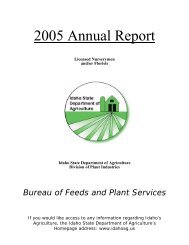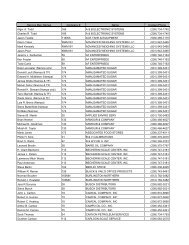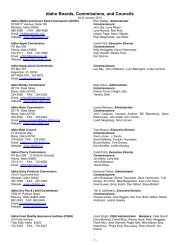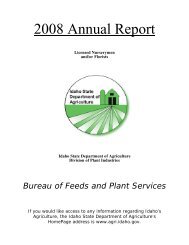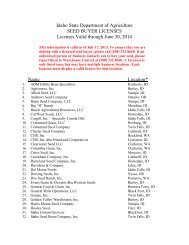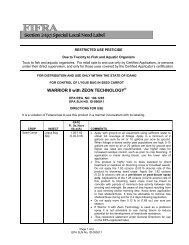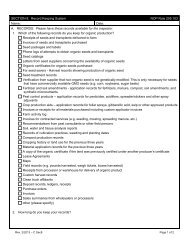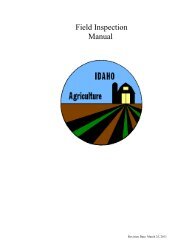2008 Statewide Strategic Plan for Eurasian Watermilfoil in Idaho
2008 Statewide Strategic Plan for Eurasian Watermilfoil in Idaho
2008 Statewide Strategic Plan for Eurasian Watermilfoil in Idaho
You also want an ePaper? Increase the reach of your titles
YUMPU automatically turns print PDFs into web optimized ePapers that Google loves.
Excessive uncontrolled growth of aquatic weeds alters water quality by chang<strong>in</strong>g dissolved<br />
oxygen patterns, pH, carbon dioxide, alters light penetration, zooplankton and phytoplankton<br />
populations, among other parameters. Likewise, weed control activities, whether mechanical or<br />
herbicidal can cause short term water quality changes depend<strong>in</strong>g upon the method of control and<br />
the amount (area and biomass) of vegetation controlled.<br />
For example, Chapter 403.088, section 1 of the Florida Statutes (www.leg.state.fl.us/statutes)<br />
essentially allows the Florida Department of Environmental Protection (FDEP) to conduct and<br />
permit aquatic weed control activities without hav<strong>in</strong>g to get a pollution control permit from the same<br />
agency. This statute has saved the FDEP as the lead aquatic plant management agency <strong>in</strong> public<br />
waters extensive and unnecessary water quality monitor<strong>in</strong>g and submission of permit applications.<br />
The relevant section of the statute is repr<strong>in</strong>ted below.<br />
403.088 Water pollution operation permits; conditions.--<br />
(1) No person, without written authorization of the department, shall discharge <strong>in</strong>to waters<br />
with<strong>in</strong> the state any waste which, by itself or <strong>in</strong> comb<strong>in</strong>ation with the wastes of other<br />
sources, reduces the quality of the receiv<strong>in</strong>g waters below the classification established <strong>for</strong><br />
them. However, this section shall not be deemed to prohibit the application of pesticides<br />
to waters <strong>in</strong> the state <strong>for</strong> the control of <strong>in</strong>sects, aquatic weeds, or algae, provided the<br />
application is per<strong>for</strong>med pursuant to a program approved by the Department of Health, <strong>in</strong><br />
the case of <strong>in</strong>sect control, or the department, <strong>in</strong> the case of aquatic weed or algae control.<br />
The department is directed to enter <strong>in</strong>to <strong>in</strong>teragency agreements to establish the<br />
procedures <strong>for</strong> program approval. Such agreements shall provide <strong>for</strong> public health,<br />
welfare, and safety, as well as environmental factors. Approved programs must provide<br />
that only chemicals approved <strong>for</strong> the particular use by the United States Environmental<br />
Protection Agency or by the Department of Agriculture and Consumer Services may be<br />
employed and that they be applied <strong>in</strong> accordance with registered label <strong>in</strong>structions, state<br />
standards <strong>for</strong> such application, and the provisions of the Florida Pesticide Law, part I of<br />
chapter 487.<br />
Recommendation 4.1: Establish temporary water quality exemption by statute.<br />
The <strong>Idaho</strong> Department of Agriculture should codify the exemption of approved aquatic weed<br />
control operations from state water quality standards as necessary to facilitate the control of<br />
aquatic weeds with<strong>in</strong> the framework of <strong>Idaho</strong> law/rules and regulations.<br />
ISDA Response: ISDA will work with DEQ to resolve this issue.<br />
Issue 5.0 Invasive aquatic weed list<br />
The aquarium and water garden <strong>in</strong>dustry and aquatic and wetland restoration projects have high<br />
potential to <strong>in</strong>troduce new and even more aggressive <strong>in</strong>vasive weeds <strong>in</strong>to <strong>Idaho</strong>. Recent research<br />
conducted <strong>in</strong> M<strong>in</strong>nesota clearly shows that not only state listed noxious weeds, but even federally<br />
designated noxious weeds were commonly found <strong>in</strong> shipments of aquatic and wetland plants<br />
imported <strong>in</strong>to that state (Maki and Galatowitsch, 2004, Biological conservation 118:389-396).<br />
Current draft revisions to IDAPA02, Title 06, Chapter 22, Noxious Weed Rules, proposes addition<br />
of Egeria densa, Hydrilla verticillata and Eichhornia crassipes to the <strong>Idaho</strong> Noxious Weed list.<br />
There are two known species of Egeria, densa and najas, and there are additional potentially<br />
noxious species of Eichhornia.<br />
Other genera of aquatic plants caus<strong>in</strong>g major problems <strong>in</strong> northern states and also <strong>in</strong> states near<br />
<strong>Idaho</strong> <strong>in</strong>clude species (or lower taxa) of Phragmites, Cabomba, Potamogeton crispus, and Trapa.<br />
These genera are expand<strong>in</strong>g and becom<strong>in</strong>g <strong>in</strong>creas<strong>in</strong>gly problematic <strong>in</strong> the USDA plant hard<strong>in</strong>ess<br />
zones 4, 5 and 6 <strong>in</strong> the Northeast, Michigan and Kansas/Nebraska<br />
(www.usna.usda.gov/hardzone) which have similar climatic conditions to large portions of western<br />
<strong>Idaho</strong>.<br />
64



